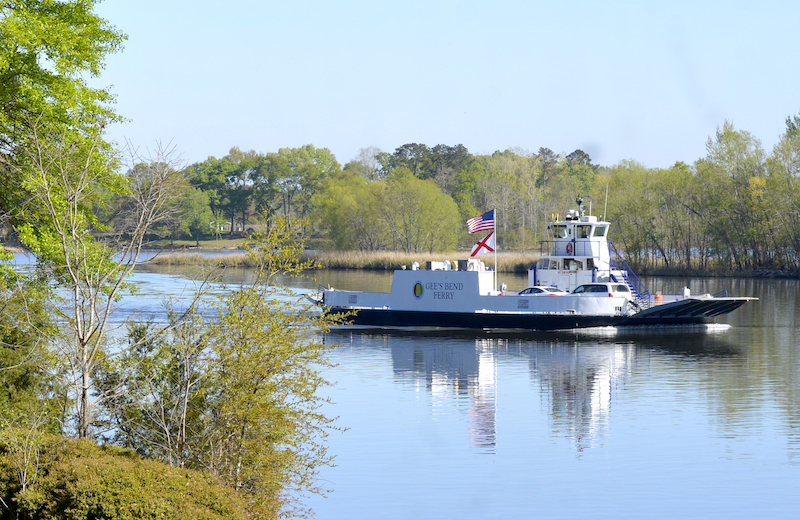The first zero-emission, all-electric passenger/vehicle ferry in the U.S. marked its first anniversary this spring after a conversion that cleared a few hurdles.
Alabama’s Gee’s Bend Ferry completed its annual COI, “and that was very successful. The vessel has worked as envisioned and is doing it safely,” said Tim Aguirre, general manager, HMS Ferries Inc., which operates the ferry for the Alabama Department of Transportation. “We knew there would be challenges with it.”
Among them was the rural location, which meant the electrical infrastructure had to be improved. “If you’re going to have a speedy charge, they have to have a more robust infrastructure,” he said.
The 95’x42’x5’, 15-vehicle/132-passenger ferry makes five round trips daily across the Alabama River between Gee’s Bend and Camden. While charging stations are on both sides of the river, the boat was designed so it could charge on just one side. “We have more margin than we could have hoped for,” Aguirre said. Charging takes 20-25 minutes on one side or 10-15 minutes on both sides.
Another challenge was the Coast Guard’s lack of regulations for lithium-ion battery-powered Subchapter T vessels.
“We brought the Coast Guard in right at the beginning,” Aguirre said. Naval architects “Glosten did an outstanding job of submitting all of the plans early on. There was a fair amount of give and take.”
Glosten sent the Coast Guard their basic design and what they intended to do, and the agency sent a reply with its expectations for an equivalent level of safety, said Sean Caughlan, senior marine engineer at the Seattle firm.
Citing increased interest in battery and other new types of stored energy technology, the Coast Guard last October issued design guidance for lithium-ion battery installation on commercial vessels. Recommendations include providing step-by-step instructions for the crew in case of a battery fire or threat to the battery compartment.
“From a design point of view, one of the first challenges we had was how big to make the batteries,” Caughlan said. What’s an appropriate lifetime for batteries on a battery-powered vessel? To get a 20-year life, for example, “You’d have to make the batteries much larger than you need.”
They settled on a 10-year life and others are now considering a four-year life. “You would never make that choice of an engine that only lasts four years,” he said. “Now that the vessel’s operating, I think we got it right.”
The batteries are air cooled, and because they’re in an enclosed space, the only way to get the heat out is to air condition it. Thus, they had to install a unit to cool the space.
The $1.8 million project was funded in part with a $1.09 million Environmental Protection Agency (EPA) Diesel Emissions Reduction Act (DERA) grant. The state kicked in the rest.
The conversion at Master Marine Inc., Bayou La Batre, Ala., involved removing four 125-hp John Deere engines from the vessel, which was built in 2004. Replacement equipment included new propulsion motors, new gears and two Spear battery banks (135-kWh each). For the fire suppression system, each battery space is serviced by 3M Novec 1230 fire protection fluid.
Operating costs were expected to be about 50% less because fuel would be replaced with cheaper electricity for the charging stations. The world’s first zero-emission ferry, the MF Ampere operated by Norway’s Norled AS, entered service in 2015. Fuel costs were cut by almost 80%, an executive told WorkBoat when the Alabama project was getting underway a few years ago.
Because of the recent energy cost drop, it’s going to take a little longer to recoup the savings for this green initiative.
But, Aguirre said, “We can honestly say it’s a zero-emission vessel.”




